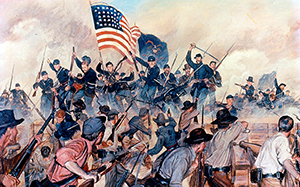
Highlender was arrested by provost marshals from the Union army for sewing a gray shirt for her 17-year-old nephew who was serving as a Confederate soldier, said her great-great-grandson, Warren County author and historian Gordon Cotton.
“She got caught and imprisoned and then exiled from Warren County for the rest of the war because she made that shirt,” Cotton said.
Highlender’s punishment, which by today’s standards seems arbitrary and capricious, was not unusual during the occupation period, and official records and personal letter from Union soldiers and residents of Vicksburg describe hundreds of instances of turmoil, looting and crimes by and against the soldiers who had taken over the city in July 1863.
“The people of Vicksburg discovered they were people without a country. They were under military occupation and had no rights,” Cotton said. “For the rest of the war we were an occupied territory like Japan after World War II.”
Military passes were required to leave the city, and a curfew made it illegal to be out at night. On Christmas 1863, at least one minister was ordered by Union soldiers to publicly pray for President Abraham Lincoln, who did not even appear on the ballot in Mississippi in 1860.
Children as young as 12 were arrested and listed on jail dockets “to be held as hostages,” according to official records.
Residents of the city were forced to sign loyalty oaths, Cotton said, and those who refused to sign the oath were not given rations.
Things weren’t much easier for those who signed the oath and jumped through bureaucratic hoops to get food.
On July 22, 1863, Pvt. Dick Puffer of Illinois wrote to his sister that people were coming into Vicksburg from a 20-mile radius to get rations because they “had been robbed by one army or the other of all they had.”
“Some of them look rather humble,” Puffer wrote. “But hunger breaks down all rules of etiquette.”
Sgt. W.L. Brown of the Chicago Mercantile Battery described lines of “men who before the war counted their fortunes by hundreds of thousands, ladies who never before knew the difference between a hind quarter of mutton and a hind quarter of beef, contrabands who had always trembled in the presence of their masters, poor white trash and, last but not least, Uncle Sam’s own blue-uniformed soldiers — all mixed in a heavy mess, trying to be in the first to have his or her order filled.”
About 30 Warren County residents who signed the oath but were not trusted by Union soldiers and generals were added to a secret list detailing Union suspicions. The list was discovered about 20 years ago in the attic of the Old Court House Museum, Cotton said, and now is on display in the museum’s Confederate Room.
Brig Gen. James B. McPherson, one of the most popular Union generals among Vicksburg residents during Occupation, wrote of a group of distrusted residents in Yokena and Campbell’s Swamp in his official records.
“There is a class of persons in that section who require watching; although seemingly disposed to remain quietly at home and pursue their peaceful avocation, they are hostile in spirit,” McPherson wrote.
Union sympathizers living in Vicksburg were treated the same as any other Southerners, as is evident in the letters of Lewis S. Houghton, a Warren County judge who was from New York and supported the U.S. government, Cotton said.
“In his letters he was longing for the day U.S. troops would come, but to his dismay, he was treated just like everyone else,” Cotton said.
For newly freed slaves, life in Vicksburg wasn’t much better. About 25,000 freedmen followed Gen. Ulysses S. Grant’s army into the city, but thousands of the former slaves, who had never been in such large groups before, caught diseases and died.
Surviving freedmen who were enlisted into the U.S. Colored Troops were given charge of the city under white officers in 1864 when many of the soldiers who had fought at Vicksburg moved toward Atlanta.
___
Information from: The Vicksburg Post, http://www.vicksburgpost.com
# # #
Copyright 2013 Associated Press. All rights reserved. This material may not be published, broadcast, rewritten, or redistributed.
ADDITIONAL IMAGE OF NOTE



